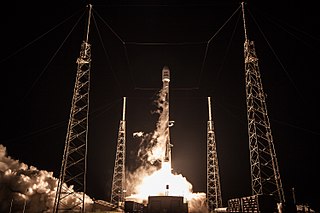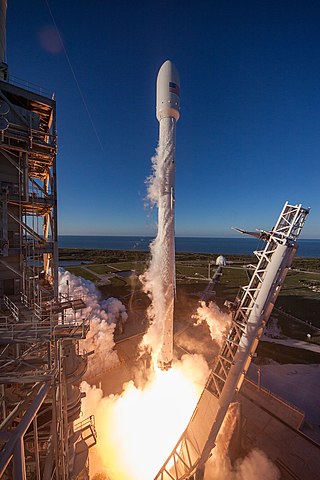
Ariane 5 is a retired European heavy-lift space launch vehicle developed and operated by Arianespace for the European Space Agency (ESA). It was launched from the Centre Spatial Guyanais (CSG) in French Guiana. It was used to deliver payloads into geostationary transfer orbit (GTO), low Earth orbit (LEO) or further into space. The launch vehicle had a streak of 82 consecutive successful launches between 9 April 2003 and 12 December 2017. Since 2014, Ariane 6, a direct successor system, is in development.

A geostationary transfer orbit (GTO) or geosynchronous transfer orbit is a type of geocentric orbit. Satellites that are destined for geosynchronous (GSO) or geostationary orbit (GEO) are (almost) always put into a GTO as an intermediate step for reaching their final orbit.

Skynet is a family of military communications satellites, now operated by Airbus Defence and Space on behalf of the United Kingdom's Ministry of Defence (MoD). They provide strategic and tactical communication services to the branches of the British Armed Forces, the British intelligence agencies, some UK government departments and agencies, and to allied governments. Since 2015 when Skynet coverage was extended eastward, and in conjunction with an Anik G1 satellite module over America, Skynet offers near global coverage.

SES S.A. is a Luxembourgish satellite telecommunications network provider supplying video and data connectivity worldwide to broadcasters, content and internet service providers, mobile and fixed network operators, governments and institutions.
SES Americom was a major commercial satellite operator of North American geosynchronous satellites based in the United States. The company started as RCA Americom in 1975 before being bought by General Electric in 1986 and then later acquired by SES S.A. in 2001. In September 2009, SES Americom and SES New Skies merged into SES World Skies.
MEASAT Satellite Systems Sdn. Bhd., formerly Binariang Satellite Systems Sdn. Bhd., is a Malaysian communications satellite operator that owns and operates the MEASAT and AFRICASAT spacecraft. The company provides satellite services to leading Malaysian broadcasters, Direct-To-Home (DTH) platforms and telecom operators. With capacity across six communication satellites, the company provides satellite services to over 150 countries.

Inmarsat is a British satellite telecommunications company, offering global mobile services. It provides telephone and data services to users worldwide, via portable or mobile terminals which communicate with ground stations through fifteen geostationary telecommunications satellites.
Paksat-1,, was a geosynchronous and communications satellite built and owned by the Boeing Company, leased to the Space & Upper Atmosphere Research Commission (SUPARCO) and renamed Paksat-1. It was successfully put on orbit on 1 February 1996 as Palapa-C1 for Indonesia as its original customer. But, after the technical problems, the satellite was leased to SUPARCO at an orbital location of 38° East longitude in December 2002. Paksat-1 offers the C-band and Ku-band coverage in over 75 countries across Europe, Africa, Middle East, South and Central Asia. Its customers included government organizations, television broadcasters, telecommunications companies, data and broadband internet service providers.
HYLAS is a British satellite in geostationary orbit. HYLAS, which is an acronym for Highly Adaptable Satellite, is a communications satellite and was launched by the European Ariane 5 launch vehicle from the Guyana Space Centre at Kourou in French Guiana. It is located at the orbital location of 33.5 degrees west and will provide new and innovative services including High Definition Television (HDTV) and interactive satellite delivered broadband services. The satellite will help address the issue of poor broadband coverage in many parts of Europe which have less developed ground infrastructure.

Artemis was a geostationary earth orbit satellite (GEOS) for telecommunications, built by Alenia Spazio for ESA. The Artemis satellite operated at the 21.5E orbital position until 2016, when it was moved to 123E to cover the L-Band spectrum rights for Indonesia's Ministry of Defense.
Astra 1M is a geostationary communications satellite which is operated by SES. It is positioned in geostationary orbit at a longitude of 19.2° East, from where it is used to provide direct to home (DTH) broadcasting to Europe, Africa, and the Middle East.
The European Data Relay System (EDRS) system is a European constellation of GEO satellites that relay information and data between satellites, spacecraft, UAVs, and ground stations. The first components were launched in 2016 and 2019.

The space segment of an artificial satellite system is one of its three operational components. It comprises the satellite or satellite constellation and the uplink and downlink satellite links.
HYLAS 2 is a geostationary High throughput satellite operated by Avanti Communications. HYLAS, an acronym for Highly Adaptable Satellite, was launched on Ariane 5 from Guyana Space Centre at Kourou, French Guiana, on August 2, 2012.

Inmarsat-4A F4, also known as Alphasat and Inmarsat-XL, is a large geostationary communications I-4 satellite operated by United Kingdom-based Inmarsat in partnership with the European Space Agency. Launched in 2013, it is used to provide mobile communications to Africa and parts of Europe and Asia.

SES-12 is a geostationary communications satellite operated by SES S.A.

Intelsat 35e, also known as IS-35e is an Intelsat high-throughput (HTS) geostationary communications satellite designed and manufactured by Boeing Satellite Systems on the Boeing-702MP satellite bus. It was launched on 5 July 2017.
HYLAS-4 is a telecommunications satellite owned and operated by Avanti Communications and manufactured by Orbital ATK that was launched by an Ariane 5 rocket on 5 April 2018.
Spainsat NG is a Spanish communications satellite program aimed at developing next-generation satellites to meet Spain's government and military secure communications needs.
Intelsat 39, also known as IS-39, is a geostationary communications satellite operated by Intelsat and designed and manufactured by Space Systems/Loral on the SSL 1300 satellite bus. It covers Asia, Africa, Europe, and the Middle East from the 62° East longitude. It has a mixed C-band and Ku-band.










